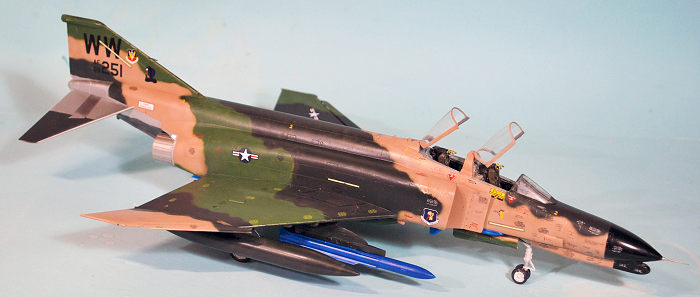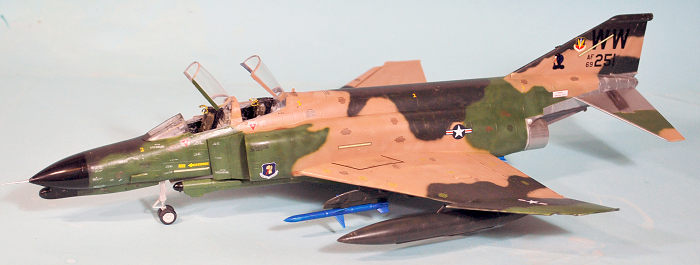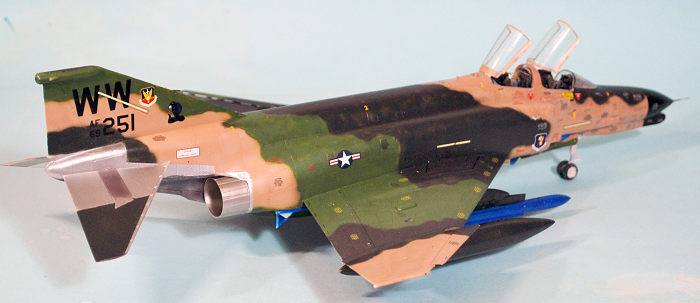
Hasegawa 1/48 F-4G Phantom II
| KIT #: | PA 2200 |
| PRICE: | $ |
| DECALS: | Two options |
| REVIEWER: | Tom Cleaver |
| NOTES: | Xtradecals 48-241 |

| HISTORY |
As Captain Terry Martin of the 562nd Tactical Fighter Squadron of the 37th Tactical Fighter Wing told me when I visited the wing at George AFB in May 1982 on assignment from Air Force Magazine to do an article on the Wild Weasels, “You’ll know the F-15 is obsolete when you read that it’s replaced the Phantom in the Wild Weasels.” It didn’t quite happen that way - the “Wild Weasel” SEAD (Supression of Enemy Air Defenses) assignment is now performed by the F-16 (also proving Captain Martin’s comment) - but the F-4G did come at the end of the development line of the McDonnell-Douglas fighter, when it was becoming obsolescent and was replaced in frontline tactical fighter units by the F-15 Eagle.
The “Wild Weasel” assignment grew out of the need in the 1960s in the Vietnam War to provide a way of suppressing the North Vietnamese use of the SA-5 SAM that gave the US Air Force fits during Operation Rolling Thunder, the bombing of North Vietnam.
 The
first Weasel aircraft was the F-100F, which appeared in late 1965 and
had electronic gear that could lock onto the radar frequency of the
SA-5, but was limited to finding out the exact position of the launcher
by flying directly over the site. This was quickly replaced by 1967 with
the F-105F Thunderchief, which was equipped with gear that was a bit
more sophisticated and used the Shrike radar-homing missile to knock out
the SAM. This was followed by 1969 with the F-105G, an F-105F modified
with even more advanced gear, and using both the Shrike and the HARM
(High-speed Anti-Radiation Missile) that could be used against a SAM
site from a longer distance.
The
first Weasel aircraft was the F-100F, which appeared in late 1965 and
had electronic gear that could lock onto the radar frequency of the
SA-5, but was limited to finding out the exact position of the launcher
by flying directly over the site. This was quickly replaced by 1967 with
the F-105F Thunderchief, which was equipped with gear that was a bit
more sophisticated and used the Shrike radar-homing missile to knock out
the SAM. This was followed by 1969 with the F-105G, an F-105F modified
with even more advanced gear, and using both the Shrike and the HARM
(High-speed Anti-Radiation Missile) that could be used against a SAM
site from a longer distance.
The F-105 Weasels were replaced in the postwar period by the EF-4C Phantom II, which used essentially the same detection equipment and weapons as the F-105G; this was done because there were more F-4C Phantoms available than F-105Fs for conversion to the Wild Weasel mission.
F-4G Wild Weasels were modified F-4E fighters with their cannon replaced by AN/APR-47 electronic warfare equipment. 116 F-4Es were rebuilt as F-4Gs for this assignment.
Carrying AGM-88A/B/C High Speed Anti-Radiation Missiles (HARM), the F-4G carried a pilot and an Electronic Warfare Officer (EWO), who navigated, assisted with communications and coordinated attacks on SAM sites. The F-4G Wild Weasel first flew in 1975 and was retired in 1996.
Various combinations of AGM-45 Shrike, AGM-88 HARM and AGM-65 Maverick missiles were used for SEAD. Self defense was carried in the form of three AIM-7F Sparrows and/or four AIM-9L Sidewinder air-to-air missiles. The two General Electric J79-GE-17A engines were smokeless, getting rid of the Phantom’s signature smoky trail that allowed enemy pilots to spot F-4 formations before the aircraft themselves were visually detected. The F-4G used the F-15 centerline tank, which could remain attached to the aircraft during air combat maneuvering.
The AN/ANR-47 gear could track up to 38 different targets simultaneously, and could identify sites that could resppond to the aircraft (to be avoided) and those that could not (to be attacked). As Colonel Sam “Papa Bear” Peacock - at the time the senior Weasel EWO, whose participation in the job went back to the F-100s - said to me in explaining the gear (to his later embarrassment with the other members of the wing when I quoted him in the article), “When this gear is running right, it’s like ‘The Force is with you,’ since it allows you to run circles around the bad guys.”
The Phantom That Came Close To Punching My Ticket:
My assignment from Air Force Magazine included a flight with the Weasels. I had gone to Edwards to get my high altitude card a few days earlier, and the prospect of being PAID to go for a ride in an F-4 Phantom was exciting. I spent some four hours being trained how to survive the ride with particular emphasis on surviving an ejection - which the guys who were training me assured me was a highly unlikely event - before I strapped into the back seat of one of the F4E trainers, with Captain Martin in the front seat. We would accompany two F-4Gs into the Red Flag Range in Nevada for a simulated Weasel mission. Sam Peacock was the senior EWO.
 Yes
indeed, takeoff in an F-4 is definitely memorable as you are pressed
into your seat by about 4Gs when the afterburners are lit off. The
flight up to the range was a photographer’s delight as I asked my pilot
to position us around the two Weasels while I burned through about eight
rolls of Kodachrome-64.
Yes
indeed, takeoff in an F-4 is definitely memorable as you are pressed
into your seat by about 4Gs when the afterburners are lit off. The
flight up to the range was a photographer’s delight as I asked my pilot
to position us around the two Weasels while I burned through about eight
rolls of Kodachrome-64.
Then we arrived at the Red Flag range and dropped down for the attack run. 550 knots at an altitude of under 500 feet is exhilarating as hell, with the ground outside a blur at that speed. But all of a sudden, I heard Colonel Peacock call an abort. We all pulled up - and that was when things got hairy. The F-4Gs were flying a standard two-ship mission, and maneuvering as such. Our F-4E was a third wheel. All of a sudden I looked up at the F-4G with Colonel Peacock in the back seat as it flashed overhead at a distance later determined to be “less than 20 feet.” The moment was so fast that by the time the image got from my eye to my brain it was over.
The Weasels made their second attack run and we went with them, but this time, when they pulled up from the run, we stayed low and straight, passing well under them before pulling up behind them and joining the two for the trip back to George.
In the O-Club bar after the post-flight briefing, I commented that our close encounter had been “pretty exciting.” Captain Martin then told me we had been about 30 seconds from him punching us out, to escape the approaching midair collision, when he saw the other plane’s nose moving to the side and realized we would have a near-miss rather than a collision. “You came real close to putting all that training to use.” Sam Peacock said it was “the scariest moment I’ve ever had in an airplane.”
Ten years later, Sam Peacock, by then the only “Back Seater Wing Commander in the Air Force,” led the Weasels to downtown Baghdad on the first night of Operation Desert Storm, and over the course of 18 minutes put all those years of training to use when they took out the entire Iraqi air defense system with no losses.
| THE KIT |
Hasegawa first released an F-4G in their range of 1/48 Phantoms about five years after my flight. That kit was a modification of their first F-4E release, with poor fit and raised detail. This kit was the first of two later releases in the early 1990s, in which the surface detail was engraved, and an F-16 centerline tank was included with the later HARM and Shrike missiles.
 I
decided to pick up the kit and build this model when XtraDecals released
sheet 48241, which offered markings for F-4G 69-251,the airplane that nearly
killed me. The airplane was in its 1981 SEA tri-color camo with light grey
lower surfaces. I decided to do it as it appeared in 1982, fresh out of IRAN
with the then-new “over-under” SEA scheme.
I
decided to pick up the kit and build this model when XtraDecals released
sheet 48241, which offered markings for F-4G 69-251,the airplane that nearly
killed me. The airplane was in its 1981 SEA tri-color camo with light grey
lower surfaces. I decided to do it as it appeared in 1982, fresh out of IRAN
with the then-new “over-under” SEA scheme.
I obtained an Aires resin cockpit (more on that mistake below) and a pair of MB Mk.7 seats with molded-in seatbelts, to improve things.
As it turned out, this kit would fight me tooth and nail over the next seven months, with several long stretches spent with it sitting in its box while I considered whether I was really committed to having The Phantom That Nearly Killed Me in my collection.
| CONSTRUCTION |
The basic Hasegawa kit is quite simple. It’s not as detailed as modern F-4 kits like the Meng F-4G, but it was also available on eBay for about a third the cost of the Meng kit. Basically, this project was another opportunity to learn that You Get What You Pay For. In retrospect, the Meng kit would have been cheaper and easier, since I wouldn’t have felt the need to get that ferschlugginah resin cockpit.
 Aires
cockpits frequently do not really fit the model they’re designed for, and
that was the case here. After I cleared out all the interior fittings to
install the kit cockpit - thus insuring that I was committed to the Aires
cockpit - I found out with test fitting that it didn’t - fit. Quite a bit of
modification ensued with my Dremel and files, and in the end I discovered
the thing was installed (with lots of super glue to insure it was completely
permanent) with a two-degree “tilt.” There was further work with the Dremel
to get the right fuselage half to be able to join up with the left, and I
made sure to glue the seats in vertically. Viewed from most directions, you
can’t tell the cockpit is fakakte.
Aires
cockpits frequently do not really fit the model they’re designed for, and
that was the case here. After I cleared out all the interior fittings to
install the kit cockpit - thus insuring that I was committed to the Aires
cockpit - I found out with test fitting that it didn’t - fit. Quite a bit of
modification ensued with my Dremel and files, and in the end I discovered
the thing was installed (with lots of super glue to insure it was completely
permanent) with a two-degree “tilt.” There was further work with the Dremel
to get the right fuselage half to be able to join up with the left, and I
made sure to glue the seats in vertically. Viewed from most directions, you
can’t tell the cockpit is fakakte.
The project was stalled several times when parts were dropped, falling into The Department of Lost and leading to long periods of thinking that the project had finally arrived at the point it should be put out of its misery,when the lost parts would miraculously reappear after escaping from The Department of Lost.
Finally, it was all assembled and ready for painting.
| COLORS & MARKINGS |
I used the painting diagram for the over-under SEA scheme that was on the decal instructions for a different markings option, using Mr. Color paints. I previously painted the rear fuselage with various colors of Tamiya lacquer metallics and masked them off.
 The
extensive stencils for the Phantom that were on the kit sheet turned out to
be too old to use, so I found a “used” set of Early Phantom Stencils from
Eagle Strike (48208) and plastered the model with stencils in
approximately-correct positions, then applied the markings for 69-251.
The
extensive stencils for the Phantom that were on the kit sheet turned out to
be too old to use, so I found a “used” set of Early Phantom Stencils from
Eagle Strike (48208) and plastered the model with stencils in
approximately-correct positions, then applied the markings for 69-251.
I applied coat of Tamiya lacquer Clear Flat to the model, then assembled and attached the landing gear, the inner pylons, the wing tanks and the centerline tank. I painted the Sparrows, the HARM and the Shrike blue as “inert rounds,” which was the load carried by 69-251 42 years ago (Good grief, has it really been that long? It has.) I attached the weapons, then unmasked the canopy and attached the pilot’s and EWO’s canopies in the open position. I declared victory and beat a hasty retreat before anything fell off.
| CONCLUSIONS |
If you want an F-4G, the kit to get is the Meng SWS kit. You don’t need any aftermarket. That said, this model would have been much easier if I had used the kit-supplied cockpit with the resin seats. With care, the Hasegawa kit can be turned into a nice model. Now I have The Airplane That Nearly Killed Me in my collection.
20 September 2024
Copyright ModelingMadness.com. All rights reserved. No reproduction in part or in whole without express permission from the editor.
If you would like your product reviewed fairly and fairly quickly, please contact the editor or see other details in the Note to Contributors.